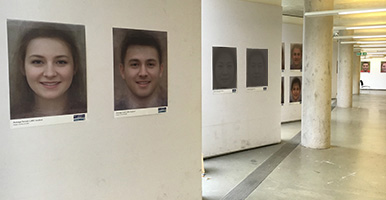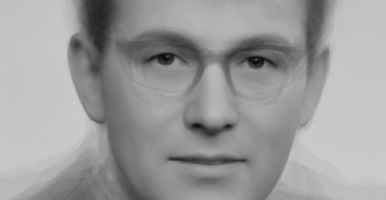About the project
Discover more about the Faces of Merseyside
About the online exhibition
Created and presented by LJMU's Face Lab, the images used in the Faces of Merseyside project represent the range of facial averages of the people of Merseyside. In September 2016, the images were exhibited as a part of the 7th International Conference on the Image: Face Value – Personification and Identity in a Post-Digital Age, in the School of Art and Design at LJMU. The conference investigated the themes: nature, form and function of images; the processes and spaces of image creation; and the social effects of images.
Faces of Merseyside addresses the importance of the face in identity, character and social groups. The images were produced using image morphing software in which individual face shape and features are blended together to render an average. A minimum of 20 faces contributed to each average facial image for a given group – including artists, students, teachers, athletes, health professionals, police officers and criminals.
The video shows the process used by Face Lab to generate facial averages with the image morphing software.
Although based on Merseyside residents, the project aims to generate a greater understanding of the differences and similarities between people within the context of a wider application to UK and international communities and current interests in national identity, social cohesion and migrating world populations.
History of facial averages
Sir Francis Galton created composite images of faces in the 1800s by projecting photographs of different individuals onto a single piece of photographic film. He wanted to represent the ‘typical’ face of criminals or soldiers by demonstrating a facial appearance common to one or the other group. More recently, psychologists have created composite faces using computer graphic methods which generate the average characteristics of a number of constituent faces – and in doing so, produce facial images with greater clarity and detail that those of Galton’s methods.
Facial attractiveness, gender and age related changes, aspects of ancestry and nationality, as well as faces assessed ‘by city’ have been studied through the use of facial averages. Researchers however, have not studied faces as they relate to occupation or interests, making the collection and exhibition of the Faces of Merseyside of potential significance in relation to our perceptions of ‘tribal’ appearance.
Population demographics for Merseyside
Ethnic group totals from the National Census are approximate because respondents may identify themselves as having more than one ethnic or cultural origin and may be affected by inconsistencies in terminology or variation in the definition of ethnic categories.
Collecting the Faces of Merseyside
Exhibitions that involve facial images can be challenging, due to subject consent, recruitment and access. Sometimes this means an assemblage of faces may never wholly represent a population of people in a given place at a given time. Human populations are often identified and grouped – at least initially – by gender, age and ethnic group. When making average faces for a population, individuals are first grouped (e.g. male or female) and then differentiated, as is the case in this study, by factors like occupation or interest, resulting in a number of sub-populations.
Subjects for the average faces were collected through a number of routes including: consenting donors, published images and image collections.




